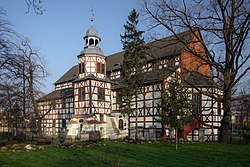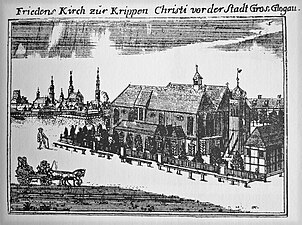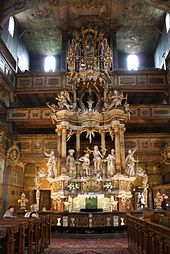Silesian peace churches
| Peace churches in Jawor and Świdnica | |
|---|---|
|
UNESCO world heritage |
|
 
|
|
| Peace churches in Jawor (above) and Świdnica (below) |
|
| National territory: |
|
| Type: | Culture |
| Criteria : | (iii), (iv), (vi) |
| Reference No .: | 1054 |
| UNESCO region : | Europe and North America |
| History of enrollment | |
| Enrollment: | 2001 (session 14) |
Three church buildings in Głogów (Glogau), Jawor (Jauer) and Świdnica (Schweidnitz) in Silesia , which were the most important Protestant church buildings in the entire Habsburg Empire , are designated as Silesian Peace Churches . They are the only three Protestant churches that were established in the Peace of Westphalia of 1648 after the re-Catholicization of Silesia at the urging of the Swedish government by the Habsburg Emperor Ferdinand III. the Protestant Silesians were granted and had to ensure the worship services for large areas in a predominantly Protestant area.
Built during the first, 1648 in Glogau and 1654 after a collapse newly built Peace Church was destroyed in 1758 in a city fire, the peace churches remained Jawor and Swidnica for over 350 years get long and stand on the since 2001 World Heritage List of UNESCO . They are the only Protestant church buildings that have this world heritage status as individual objects.
history
The resolutions of the Peace of Westphalia in 1648 included the permission for the Silesian Protestants to build three "peace churches", namely in Glogau , Schweidnitz and Jauer . However, a number of conditions had to be met: stones and bricks were forbidden as building materials, only wood, clay and straw were allowed. It was also not permitted to provide the churches with towers or bells. The only possible locations were places outside the city walls but within “cannon shot range”. The construction time could not exceed a year and the construction costs had to be borne by the community.
The Altranstadt Convention of 1707 allowed the addition of towers and bells. Then at the beginning of the 18th century a bell tower - also in the half-timbered style - was built next to the church in Schweidnitz and at the church in Jauer .
- Historical views from Friedrich Bernhard Werner : Silesian prayer houses (1748–1752)
The individual churches
Friedenskirche in Glogau
The peace church "Hut Gottes" in Glogau, built in 1648, was rebuilt after its collapse in 1654 as the church "Zur Krippen Christi", but destroyed in the town fire of 1758. The successor church “Schifflein Christi” , built from stone within the city walls of Glogau , no longer exists either. It was badly damaged in the Second World War and then demolished.
Friedenskirche in Jauer
The Friedenskirche in Jawor / Jauer was built in 1655 under the direction of the Wroclaw architect Albrecht von Saebisch (1610–1688) and offers space for 5500 people.
Peace Church in Schweidnitz
The Church of Peace in Świdnica / Schweidnitz, built in 1657, holds 7,500 people, it is the largest half-timbered church in Europe. The local carpenter Andreas Kaemper also built the huge object according to the design of the architect Albrecht von Saebisch.
World heritage
At its 14th meeting in Helsinki on December 13, 2001, the World Heritage Committee unanimously accepted the peace churches of Schweidnitz and Jauer on the list of World Heritage of Humanity . In summary, it says:
“ The peace churches are a unique testimony to the special character of political and spiritual development in Europe. They contain structural and architectural solutions that represent a successful attempt to meet the strict requirements set by the community and the builders.
At the same time, they form an architectural and artistic testimony of faith of a religious community and are an expression of their strong will to survive. Under harsh conditions, this community, with incomparable effort, created the space that is still indispensable for the worship of God today. "
Other half-timbered churches in Silesia
The buildings that still exist today are of a similar half-timbered construction as the peace churches of Jauer and Schweidnitz
- the Church of Grace in Militsch (Milicz) ,
- the border church of Kriegheide ( Pogorzeliska ) and
- the Church of the Herrnprotsch Recess ( Pracze Odrzańskie ).
literature
- Reiner Sörries: By the grace of the emperor. Protestant church buildings in the Habsburg Empire. Böhlau, Cologne a. a. 2008, ISBN 978-3-412-20154-8 , pp. 26-28, 99-103.
- Hans Caspary: The Silesian peace churches in Schweidnitz and Jauer. A German-Polish cultural heritage. With an introduction by Andrzej Tomaszewski . German Cultural Forum for Eastern Europe, Potsdam 2005, ISBN 3-936168-24-5 .
- Jörg Deventer: Counter Reformation in Silesia. The Habsburg policy of recatholization in Glogau and Schweidnitz 1526–1707 (= New Research on Silesian History. Volume 8). Cologne u. a. 2003, ISBN 3-412-06702-4 (also: Hamburg, Universität, habilitation thesis, 2000/2001).
- Churches of Peace in Jawor and Swidnica. Nomination for inclusion on the World Heritage List. September 14, 2000 (English, whc.unesco.org [PDF; 9.3 MB ] with attachments (maps, drawings, photos, etc.)).
Web links
Individual evidence
- ^ A b Reiner Sörries: By the grace of the emperor. 2008, p. 99.
- ↑ Reiner Sörries: By the grace of the emperor. 2008, p. 26.
- ↑ Joachim Lukas: Regional history notes from Silesia - Friedenskirchen. Retrieved November 16, 2016.
- ^ English text on the peace churches , accessed on June 29, 2018.




